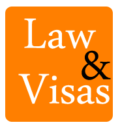An employment verification letter (EVL) is a document that proves your employment status. It’s often requested by organizations like banks, landlords, or immigration authorities to verify details about your current or past job. It’s also used as supporting evidence in immigration cases, like when applying for a green card or other visas.
Also called an “experience letter,” “proof of employment letter,” or “verification of employment” (VOE), it’s important to not confuse an EVL with the Employment Authorization Document (EAD), commonly known as a “work permit.”
When Do You Need an Employment Verification Letter?
An EVL is commonly required in immigration applications, including:
Applying for a Green Card
If you are sponsoring a relative (such as a spouse or family member) for a green card, you must show that you can financially support them. This is done by submitting a Form I-864, or Affidavit of Support, to U.S. Citizenship and Immigration Services (USCIS). Along with this form, you’ll need to provide supporting documents, including your tax return, pay stubs, and an employment verification letter.
If you’ve changed jobs or are combining income with a spouse, an EVL helps clarify your financial situation.
Self-Employed Green Card Sponsors
If you’re self-employed and want to sponsor a relative for a green card, USCIS may ask for additional proof, such as an EVL from you. This letter should include similar details as a traditional employer’s EVL. You may also need to provide other supporting documents like contracts, tax returns, and business registration papers.
Applying for a Tourist Visa
When applying for a B-2 visitor visa, which allows temporary travel to the U.S. for tourism, an EVL can show that you have a job waiting for you back home. This proves you have strong ties to your home country and can support yourself during your visit to the U.S.
Applying for a Work Visa
For work visas like the H-1B or L-1 (intracompany transfer visa), an EVL confirms your job experience. The letter should include details of your previous work history, including job titles, dates of employment, and job responsibilities.
Applying for an Employment-Based Green Card
If you are applying for an employment-based green card, an EVL is typically required to prove your work experience. This letter must detail your job responsibilities and qualifications, which may affect your approval or denial.
Applying for a Temporary Business Visa
A B-1 business visa allows you to visit the U.S. for business-related purposes without working for a U.S. company. You’ll need an EVL to confirm your job status and clarify the specific business activities you’ll be doing while in the U.S.
Key Information in an Employment Verification Letter
Although there’s no required format, your EVL should contain the following details:
- Date of letter: Must be within the last three months.
- Employment dates: Start and end dates.
- Job title: Your official job title.
- Employment type: Full-time, part-time, contract, etc.
- Salary or wage: Annual compensation.
- Job responsibilities: A summary of your duties.
- Signature line: The employer’s signature, printed name, and title.
If you’ve been furloughed or laid off due to COVID-19, you may also need to provide official documentation from your employer detailing your situation, such as when you expect to return to work.
How to Request an Employment Verification Letter
There are several ways to request an EVL:
- Ask Your Supervisor or Manager: This is often the simplest way. Provide them with all the necessary information for the letter.
- Contact Human Resources: If your company has a formal process, HR will assist you.
- Request a Template: Sometimes, organizations or agencies requesting the letter provide a template with specific details they need.
- Use an Employment Verification Service: If it’s challenging to get the letter from your employer, you can use services like InVerify or The Work Number to handle the process.
Is there a standard format for an employment verification letter
Yes, there is a standard format for an employment verification letter. The letter typically follows a formal business letter structure and includes several key components:
Essential Components
1. Letterhead and Contact Information
- Company’s official letterhead
- Employer’s full name and address
- Contact information for HR or authorized representative
2. Letter Header
- Current date
- Recipient’s name and address
- Recipient’s organization
3. Core Employment Details
The letter should include:
- Employee’s full name
- Job title
- Employment start date
- Current employment status
- Salary information (if required)
- Brief job description
4. Verification Statement
A clear statement confirming the employee’s employment status and providing essential details about their role
5. Closing
- Formal closing (e.g., “Sincerely”)
- Signature of HR representative or authorized manager
- Printed name and title
Best Practices
- Keep the letter concise (50-100 words)
- Use clear, professional language
- Verify all information for accuracy
- Only include the necessary details
- Maintain a formal, business-like tone
An employment verification letter is an essential document for various immigration applications, job-related processes, and even travel visas. Make sure the letter is accurate and includes all necessary details to avoid delays in your application.
How Law and Visas Can Help?
At Law and Visas, our team of expert immigration consultants is here to make your travel straightforward and successful. Whether you’re applying for a TN Visa or an R-1 Visa, we handle every step—from preparing your application to gathering the required documents.
Our Immigration Consultants and Lawyers ensure that your application meets the highest standards, with no details missed. We’ll also keep you informed throughout the process and coordinate with the immigration office or embassy on your behalf.
Law and Visas have a strong record of helping clients secure the visas/permits they need for International travel. You can call us today at +234 812 5505 986 to learn how we can help you.





